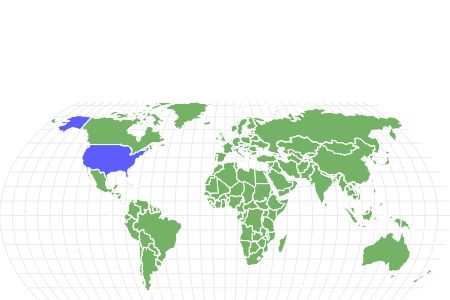Snowshoe
Felis catus
Thought to have originated in the 1960s!
Advertisement
Snowshoe Scientific Classification
- Kingdom
- Animalia
- Phylum
- Chordata
- Class
- Mammalia
- Order
- Carnivora
- Family
- Felidae
- Genus
- Felis
- Scientific Name
- Felis catus
Read our Complete Guide to Classification of Animals.
Snowshoe Conservation Status
Snowshoe Facts
- Fun Fact
- Thought to have originated in the 1960s!
- Other Name(s)
- Saimese snowshoe
- Temperament
- Affectionate, loving and loyal
- Diet
- Omnivore
View all of the Snowshoe images!
The snowshoe cat is beautiful and unique. From snuggling with loved ones to her delightful eyes, this cat is a great companion.
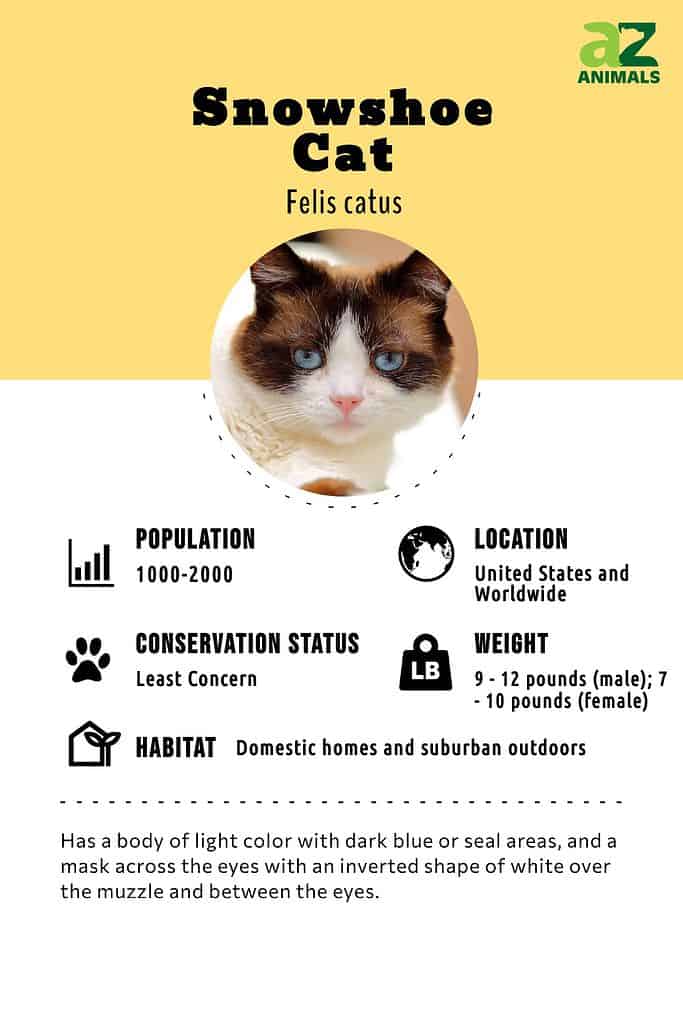
Breed History
The snowshoe cat originated in the United States in the 1960s. A Siamese cat breeder from Philadelphia, Dorothy Hinds-Daugherty, had a cat that birthed three kittens with white feet. She initiated a breeding program to produce what she first termed “Silver Laces,” created by cross-breeding bi-color American Shorthair cats and other breeds with her strangely marked Siamese cats. The quest was carried on by Vikki Olander once Hinds-Daugherty left the program, who worked to get this new breed full recognition by varied cat associations.
See all of our expert product reviews.
This breed is now 45 years old, but these cats are rare because it’s difficult to reproduce the correct markings through breeding. The marks come from a piebald pattern gene and recessive genes for color points. The appearance of the offspring is essentially unpredictable.
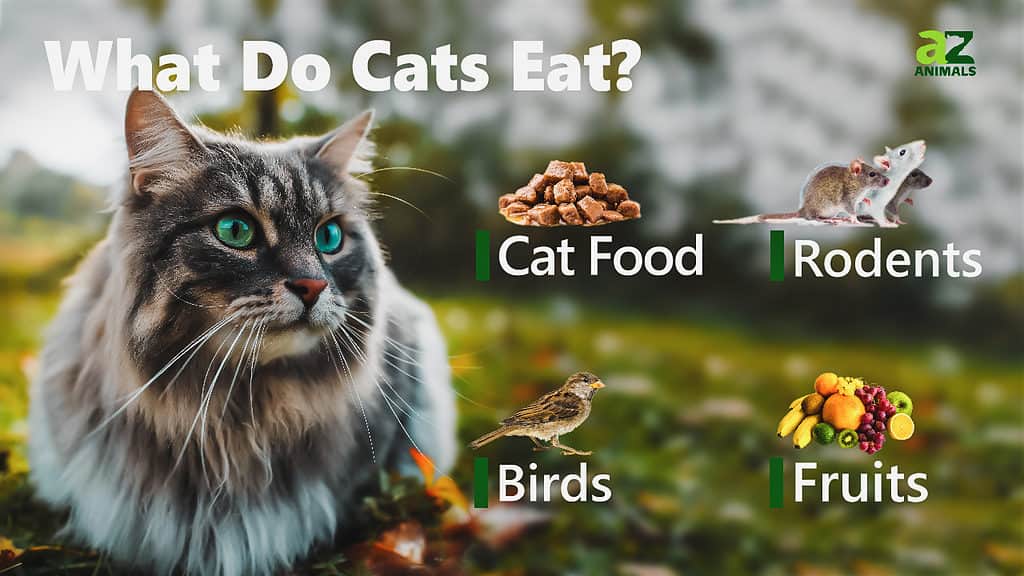
Traits: What to Know Before You Buy
Take a look at a few facts to know if you’re interested in getting a snowshoe.
Physical Characteristics
The snowshoe is of note for her color and coat markings. These traits are a direct link to her Siamese ancestry. She usually has a body of light color with dark blue or seal areas. There’s a mask across the eyes with an inverted shape of white over the muzzle and between the eyes.
Physical traits include the feline’s athletic build. The female body isn’t as sturdy as the male’s. Unlike the Siamese, the cat has a fuller, rounder face and body. The head is triangular with rounded tipped, long ears.
Another striking characteristic is the eyes. The cat’s eyes run the gamut from deep to pale blue. And regardless of the blue hue, those eyes are always bright, shining, and expressive.
Health and Entertainment for your Snowshoe
See all of our expert product reviews.
The kittens come into the world completely white. They gradually darken, developing a coat that can resemble a tuxedo. They come in a variety of colors, including lynx, lilac, and chocolate. What distinguishes the cat are the paws. They’re white. The cat-lover community calls the rear white paws “boots” and the front paws “mittens.”

©Tanasab/Shutterstock.com
Personality
The snowshoe cat’s personality is playful and can be darn mischievous. But she is also loving, kind, and intelligent. If she wants your attention, she’ll go after it, jumping in your lap when you’re busy or watching you closely.
The snowshoe isn’t a loner. She craves companionship and doesn’t like being alone, especially for long periods. She’ll find her favorite among family members. Once the snowshoe cat picks that individual, they won’t be able to get rid of her!
The cat’s personality is ideal for a home with young kiddies or other kitties. She promises to always pique your interest with her antics. Kitty will be in charge, checking on you, entertaining you, and being the friend you need.
Your snowshoe will need a little time to warm up to strangers. But for the familiar individual, expect energy and affection.
With smarts to spare, it’s common for snowshoes to figure out how to open doors. She loves running agility courses and to perform entertaining tricks. She’ll fetch and play with running water. You’ll often find her watching the world from the most unlikely places.
Kitty likes to communicate so expect the cat’s meow to become part of your lifestyle. She’ll engage in serious conversations with you. You won’t mind though. The snowshoe has a melodic, soft meow. She’ll listen closely as you go on about dinner, the job, or what you expect of her. And your cat won’t hesitate to let you know how she feels about it.
Snowshoes like company and would rather not be left by themselves all day. If you’re away from home a lot, give the kitty a friend to keep her company. This can be a dog or another feline.
While some cats do love roaming outdoors, a snowshoe’s best kept indoors. There are many dangers and diseases outside your borders. Not to mention the idea of someone on the street gladly taking your beautiful snowshoe.
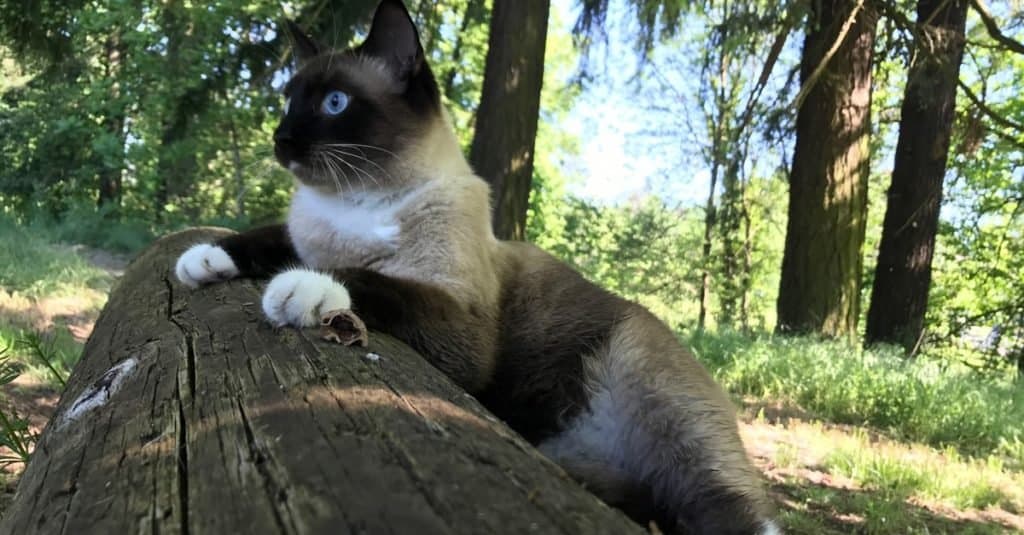
©Donna_la/Shutterstock.com
Health
All cats have genetic health concerns. Your snowshoe will be generally healthy, especially if you deal with a reputable breeder. There may be vestiges linked to your cat’s Siamese ancestry. Cosmetic flows can include crossed eyes or a kinked tail. But they won’t affect the kitty’s overall health or ability to be a great friend.
Care & Grooming
To remove dead hair, brush your cat’s coat a couple of times a week. Daily tooth brushing keeps periodontal disease away but a couple of times a week will do.
Unless she’s feeling under the weather or stressed, your cat grooms herself.
Snowshoes & Children
The snowshoe is ideal for a home with children and cat-friendly pooches. She’ll play, fetch like a retriever and perform. If treated politely and with respect, your snowshoe will always be loving and attentive.
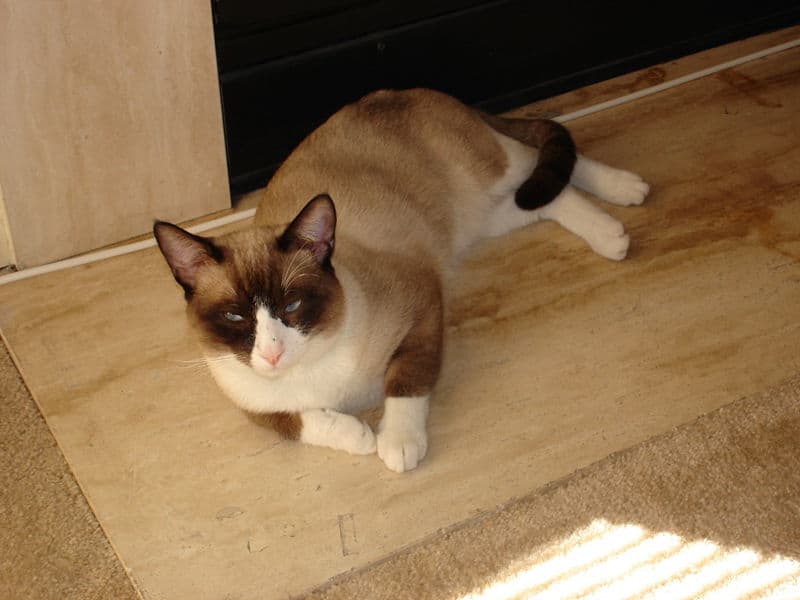
©Cooseman22 at the English Wikipedia project / Creative Commons
Size and Weight
Though every snowshoe cat is born tiny and adorable with its minuscule meow, no adult cat is the same. Breeds do have certain standards, but there will always be deviations. The snowshoe is no exception.
The snowshoe is a medium-sized creature. The male is usually larger than the female. Males weigh anywhere between 9 and 12 pounds. The female snowshoe weighs approximately 7 to 10 pounds. The snowshoe carries a hefty distribution of weight. This makes the cat seem heavier than she is.
Most members of the Siamese family fall into the same medium size and weight. You can take a look at similar breeds, like the Himalayan, Javanese, or Ragdoll cat.
Price
You’ll find the price for a snowshoe cat will range anywhere from $600 to $1,200 for purebred kittens. What drives the price is the breed’s relatively new and extreme popularity.
You can purchase snowshoe cats with limited registration. These animals will be less expensive with a price of somewhere between $500 and $800.

©nevodka/Shutterstock.com
If you can find a rescue or shelter with a snowshoe, you will only be responsible for adoption fees and shots. Not surprisingly, the price will be significantly less than you’d hand to a breeder or shop. In this case, depending on the circumstances, you may spend less than $200.
Laying out a flat figure for any costs after that has too many factors and can be easily underestimated. Two meals a day, vet bills, cat litter, cattery (if you take a vacay), and pet insurance are all included in the (ahem) kitty.
On average, a healthy, well-managed cat could cost $1,000 (in addition to adoption fees) that first year and a half that cost for every year after.
Kittens
The most obvious distinguishing feature of the snowshoe kitten is that she comes into the world with a coat of solid white colors. By seven weeks old, the kitten will be between 1.2 and 2.3 pounds. You should see signs of her coloring and patterns as well. At adoption, a healthy kitten should weigh 3.5 to 4 pounds.
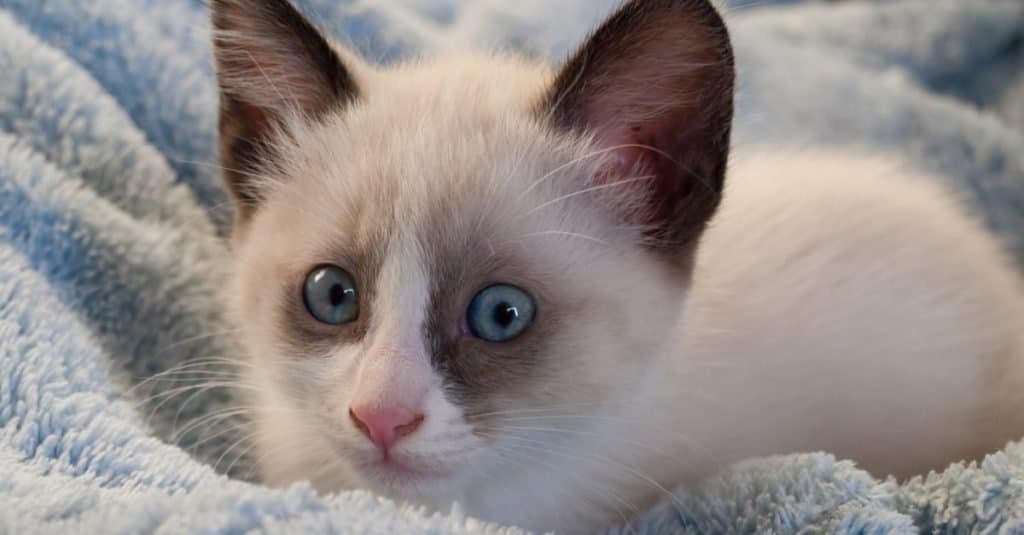
©EVasilieva/Shutterstock.com
Lifespan
The healthy snowshoe has an average lifespan of 14 to 20 years.
While there are no medical recordings of health issues specific to the snowshoe, there are some ailments that might shorten her time. She’s susceptible to viral and bacterial infections. Many are preventable or treatable if owners are responsible.
Neutering and spaying aren’t just to prevent litters. The procedures can also decrease certain cancers.
Keep up with parasite and vaccination treatments. Once she turns seven years old, your cat should get a senior exam every six months. The regimen ensures no age-related issues become major without getting treated first.
Watch out for obesity. Cats do not require the physical exercise canines do and are more likely to gain weight. Get kitty activities that promote physical play. There’s catnip, lasers, cat towers, and other toys. Obesity can lead to respiratory issues, heart disease, and diabetes.
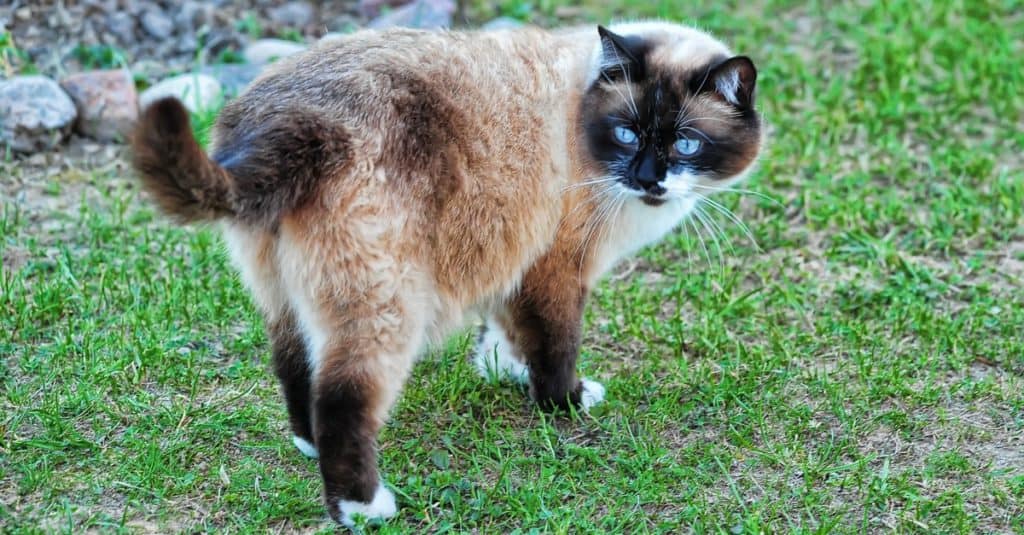
.
©Anna Krivitskaya/Shutterstock.com
Breed vs. Mixed
The snowshoe came from a crossing between American shorthairs and Siamese cats. Today, breeders use the Oriental shorthair and a stockier Siamese to engineer the snowshoe cat.
There does not appear to be any breeding to create different or new types of snowshoes. This may be because creating a snowshoe is a unique process. She’s a pointed cat. That means she has a light-colored body with dark blue or seal areas with a muzzle around her blue eyes. That muzzle can be faint or prominent but often it’s black. And of course, there are the snow-white paws.
While all the cats have traditional markings, no two snowshoe felines carry identical markings or colors, even in the same litter. Like a snowflake or a fingerprint, kittens will grow to have their own unique patterns and color.
View all 293 animals that start with SSnowshoe FAQs (Frequently Asked Questions)
Are Snowshoes herbivores, carnivores, or omnivores?
Snowshoes are Omnivores, meaning they eat both plants and other animals.
What Kingdom do Snowshoes belong to?
Snowshoes belong to the Kingdom Animalia.
What phylum to Snowshoes belong to?
Snowshoes belong to the phylum Chordata.
What class do Snowshoes belong to?
Snowshoes belong to the class Mammalia.
What family do Snowshoes belong to?
Snowshoes belong to the family Felidae.
What order do Snowshoes belong to?
Snowshoes belong to the order Carnivora.
What type of covering do Snowshoes have?
Snowshoes are covered in hair.
What genus do Snowshoes belong to?
Snowshoes belong to the genus Felis.
How many babies do Snowshoes have?
The average number of babies a Snowshoe has is 5.
What is an interesting fact about Snowshoes?
Snowshoes are thought to have originated in the 1960s!
What is the scientific name for the Snowshoe?
The scientific name for the Snowshoe is Felis catus.
Are Snowshoe Cats Rare?
The snowshoe is a rare animal. That’s somewhat due to the breeding with the distinctive patterns and markings expected in the breed. Factors such as recessive genes influence the cat’s physical characteristics. Breeders strive to produce desired standards to produce the purebred snowshoe.
How Do I Know if My Cat is a Snowshoe?
If you buy a kitten, she will be all white. The adult has a V-shaped mask, blue eyes and those delightful paws in bright white!
Are Snowshoe Cats Expensive?
Yes, they are. You can spend a price of up to $1,200 (or more depending on breeder, location and conditions). A shelter or rescue will save you some money. But that’s only if you can find these rare cats, especially kittens, in these facilities.
What is the Lifespan of a Snowshoe Cat?
The snowshoe has a lifespan range of 14 to 20 years.
Thank you for reading! Have some feedback for us? Contact the AZ Animals editorial team.
Sources
- Embrace Pet Insurance, Available here: https://www.embracepetinsurance.com/cat-breeds/snowshoe
- Pet Finder, Available here: https://www.petfinder.com/cat-breeds/snowshoe/
- Wikipedia, Available here: https://en.wikipedia.org/wiki/Snowshoe_cat
- Holistapet, Available here: https://www.holistapet.com/cat-breeds/snowshoe/
- Daily Paws, Available here: https://www.dailypaws.com/cats-kittens/cat-breeds/snowshoe
- The Spruce Pets, Available here: https://www.thesprucepets.com/snowshoe-cat-breed-profile-4769066
- Hill's Pet, Available here: https://www.hillspet.com/cat-care/cat-breeds/snowshoe
- ASPCA Pet Insurance, Available here: https://www.aspcapetinsurance.com/resources/snowshoe/
- Go Kitty, Available here: https://gokitty.com/breed/profile/cat-breed-info/snowshoe/?gclid=CjwKCAjwlYCHBhAQEiwA4K21mxlBlpt03mYLZCn8XNpHr19xV2RMeIkOuUbWh8VNdgBa91304qw6uBoCQGgQAvD_BwE
- Vet West, Available here: https://www.vetwest.com.au/pet-library/snowshoe
- Catster, Available here: https://www.catster.com/cats-101/facts-about-the-snowshoe-cat

